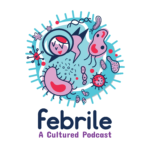Febrile Podcast Guest Page
Thank you for being a guest on the podcast! I’m looking forward to welcoming you to the show. You can find more general information about Febrile and recording an episode below. For any additional questions, please reach out to Sara!

Learn about Febrile
Febrile was created as a learning resource for ID fellows and trainees interested in ID.
This platform includes:
- an audio podcast (30-60 minutes long) that is released at least every 2 weeks
- a written supplement called “Consult Notes” (with episode summary and direct links to resources or references)
- a library of ID-related infographics
You can access these resources using the navigation header on the website.
The target audience has been ID fellows and other trainees interested in ID, but we hope that other learners or faculty members can learn from the podcast as well! In addition, the podcast covers a mixture of both adult and pediatric cases and guests.
Febrile has had >672,000 downloads in >190 countries since launch in Dec 2020. Currently ~60% of the audience listens from the United States, and ~40% listen from elsewhere around the world. [last updated 2025/02]
The podcast typically uses case-based learning to discuss high-yield or interesting ID topics. The host and/or co-host will walk the guest discussant through a case with pauses along the way to hear their insights and reasoning.
We have also trialed additional formats for the podcast as we grow and expand, such as with the “Febrile Digest”. Febrile Digest are <30 minute episodes on a variety of topics, clinical questions, or literature reviews.
You will be provided the format of the show prior to recording.
My name is Sara Dong, and I’m a Med-Peds Transplant ID physician. My brief bio can be accessed in the About Us section. You can also find me at my personal BlueSky account @sarawinndong.bsky.social or behind the Febrile account @febrilepodcast.bsky.social
I created Febrile as a learning resource for ID fellows and trainees interested in ID! I am passionate about how we can use digital education to improve ID knowledge but also to expand our community.
Febrile is produced with support from the Infectious Diseases Society of America (IDSA).
I have no disclosures.
In addition to finding Febrile here on the website, you can also access and subscribe anywhere podcasts are found.
This page will allow you to select your podcast player of choice
Set up and preparation
- The major time commitment as the discussant is approximately 45-60 minutes on the day of the recording
- We do not anticipate that you will require significant preparation time, although some guests might like to review or freshen up on their selected topic beforehand
- Once a date and time has been selected for recording your episode, you will receive a confirmation email / calendar invitation. This will include the link to the recording webpage as well as an episode outline for your reference
- Official emails you would receive correspondence from include:
- febrilepodcast@gmail.com
- swdong@bidmc.harvard.edu
- sara.dong@childrens.harvard.edu
- There should be minimal to no prep for you as the guest discussant. This can vary depending on how involved you are with reviewing the outline development though.
- The style of the show is very casual and conversational. This should be fun and enjoyable! The audience is excited to hear from you and grateful for the time you have set aside to make this episode.
- Recording a podcast is less stressful / lower stakes than items just as live media interviews because we have the luxury of editing (we can even re-record as necessary before publication)
- You will be provided a general outline of the case and questions, which is not a strict interview script. Some may like to review this prior to the recording, but overall the goal is to provide teaching similar to what you are already doing in your day-to-day life!
- We always appreciate some review/preparation from guests, although scripting out every word can make you sound less dynamic and/or like you are reading. I encourage use of bullets if you want to write out your responses, which makes you sound more natural later when you are using the outline during the recording
- I also encourage you to listen to a previous episode of Febrile if you haven’t in the past – if you want an episode recommendation, just ask Sara!
- Please check out the pre-show action items right after this for additional guidance
- Please send Sara a brief biography and headshot photo of your choice (there is space for this in the outline but you can also email)
- Please let me know if you have any financial conflicts of interest related to the topics we are discussing on your episode (such as stock or ownership interest, advising/consulting/royalties, or serving in a company role for diagnostic, therapeutic, or technology companies related to your topic)
- I would recommend trying to open your recording link to ensure you do not have any issues with accessing the recording platform ahead of time – just in case we need to troubleshoot at all!
- As a heads-up, I do ask one additional non-medicine question at the start of the show: could you share a piece of “culture” that brings you joy?
- This can be whatever you like; some suggestions might include a great book, movie, Netflix show, recipe, restaurant you’ve recently enjoyed
- Just in case you want some time to think about it
Is Febrile a live recording? Febrile is pre-recorded and NOT live. If there are any mistakes or items that we want to re-word, this can be done at the time of the recording. In addition, I oversee editing of the podcast myself in case there are any adjustments needed. I will also typically try to remove any excessive pauses or filler words as necessary. My goal is to make you sound the best that you can!
Am I going to be recorded on video? We will be able to see each other on video while we’re talking, but only audio will be recorded. You won’t be recorded on video, so feel free to dress comfortably and don’t worry about the background.
How long does the recording take? Recording should take a maximum of 60 minutes total, so I will schedule for a one-hour block of time. That said, since the podcast is less than an hour, the recording session often finishes earlier than the end of the session
How and where will we record? Virtually! Check out the next section for more details
I use “Squadcast,” which is a remote/virtual recording platform. It will look almost exactly like Zoom, but will produce much higher quality audio by recording locally.
- Squadcast uses a browser-based interface. You do not have to download software, create an account, or spend any time figuring out tech.
- You can prepare in a virtual “Green Room” where you are able to adjust your equipment.
Chrome, Firefox, and Edge browsers all support Squadcast. **Safari and iOS did not always work as well with Squadcast in the past, and I have run into difficulties there. This seems to have been fixed, but if you have issues, let me know and we can find an alternative back-up way to record**
You can also access the Squadcast “How to be a guest” page
On the day of the recording:
Click on your link
When you first join, you’ll see a “Get Started” button and be asked to allow browser permissions.
You will then see a screen that will allow you to confirm your audio settings (“Green Room”) before you formally join the session. Don’t worry you can adjust these later as well!
On the right below the video, you can see a button for “Check Equipment and Connection” — this allows you to record and playback a clip to check your settings
That’s it! I’ll help with the rest
Guests are encouraged to use an external microphone or USB headset with built-in microphone if possible. If you don’t have access to a specific headset or microphone though, it’s ok and we can use the built-in mic on your computer! At a minimum though, please have headphones available
Using earbud microphones (including AirPods) and Bluetooth headsets can have inferior sound quality which can sound a bit muffled compared to wired connections. So you can use earbuds for listening, but we may use your built-in microphone instead to record your voice
Logging into Squadcast will allow you to test your mic/headphones ahead of time if you would like
Minimize echo
Having everyone on the call use headphones will help tremendously with reducing possible echo between speakers
Natural dampening can improve the sound as well, such as working in a carpeted room or a place with furniture (couches, pillows, etc)
Try to keep a uniform distance from the microphone when speaking
Minimize background noise
Record in a quiet space if possible
Be mindful of tapping on the desk, typing, mouse clicks, turning pages, etc.
Place phone on silent if possible (as vibration can also be loud/distracting)
If next to a computer, would muting email inbox/browser tabs or computer alerts temporarily (vs muting computer volume) while recording
- Have a plan for pets/children/other people (yes, we know it doesn’t always work! And if it doesn’t, its ok – we’ve have plenty of guest appearances of family and pets on Febrile)
- Hydrate: Dry mouths/lips can make less pleasant sticky/smacking sounds for listeners
- Other tips on how to be engaging!
- Using names of others can be warm/personal. If everyone on the recording is comfortable, we’ll typically use first names
- Be positive!
- Please feel free to laugh, joke, or share your best puns 🙂 — just don’t do it at other’s expense
- Try not to ramble — the audience appreciates some back-and-forth! You can keep answers a bit more concise by having the guest host or Sara insert questions to set you up for whatever learning point you have in mind
Please use generic drug names!
Please label or comment “expert opinion” as such if you differ from guidelines or evidence based medicine
- If we are unable to use Squadcast, we may do the interview via Zoom or via an alternative method I will prepare.
- In this case, it can be helpful to record your audio locally for higher quality. Here are a few steps below:
- Windows users can use the built-in “Voice Recorder App”. Instructions:
- Launch Voice Recorder (Windows 10)
- Start > Search for Video Recorder
- Click Record
- Click the Stop button when finished
- After completing these steps, the audio file will save automatically using a .m4a file format in the “Sound recordings” folder, inside your “Documents” folder
- Launch Voice Recorder (Windows 10)
- Mac users can use the built-in “QuickTime Player” app to record yourself. Instructions:
- Launch “Quicktime” on Mac or Windows
- File > New Audio Recording > Click on the “RECORD” (red circle) button
- Click STOP when finished recording
- File > Save > Rename the file and choose a location to save it
- Launch “Quicktime” on Mac or Windows
- An alternative for Windows or Mac is downloading Audacity, a free audio application that would need to be installed
- Windows users can use the built-in “Voice Recorder App”. Instructions:
- I will discuss with you whether to email the file or upload to a designated location such as Google Drive or Dropbox.

